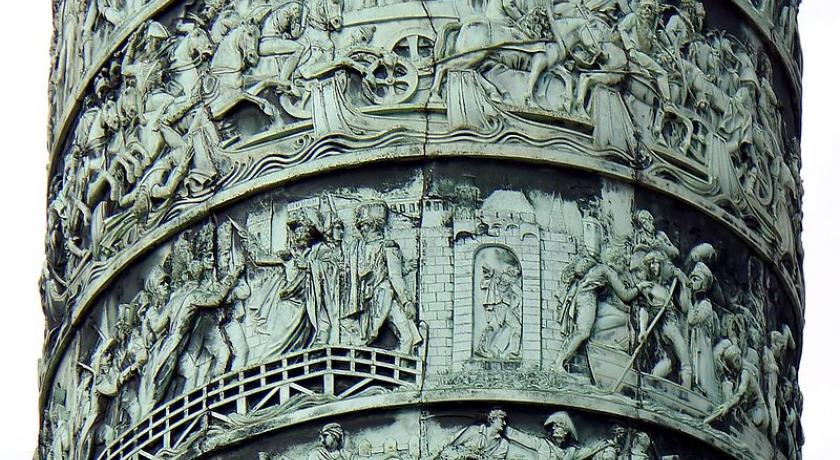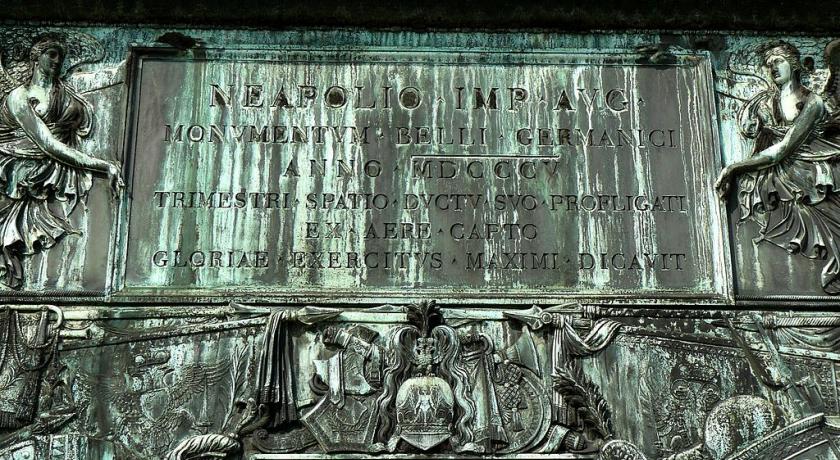Description
The Vendome column is a monument in Paris located in the center of the square with the same name in the 1st arrondissement of Paris. It was erected by Napoleon to commemorate the battle of Austerlitz. Over the years, it received the Austerlitz column names, then the column of victory before becoming a column of the Great Army. It was commonly called Vendome column. It should not be confused with the column of the Great Army, which is near Boulogne-Sur-Mer. It was classified as an Historical Monuments since the 31st of March 1992.
This site is served by the Madeleine metro stations, Opera and Tuileries.
Description
The Column
It is a bronze column of 44.3 meters high and about 3.60 meters in average diameter, placed on a base and surmounted by a statue of the 1st Napoleon. it was inspired by the Trajan's column located in the Trajan forum in Rome. This inspiration goes beyond a simple formal resemblance: it feeds the idea of cosmopolitanism of Emmanuel Kant.
It barrels, consisting of 98 stone drums, is covered with a screed bronze casting of 1 200 cannons taken from the Russian and Austrian armies (probably propagandist number, historians count about 130 canons taken at Austerlitz) and decorated in the ancient way of bas-reliefs representing trophies and scenes of battles. Continuous winding to the top, this helix, 280 m long and made up of 425 bronze plates.
The friezes Drawing in bas-relief are ordered in the year 1806 by Pierre - Nolasco Bergeret (1782-1863), François Mazois (1783-1826) and Benjamin Zix (1772-1811). Living Denon has distributed the realization of the bas-reliefs to the young talents and experienced sculptors: Lorenzo Bartolini, Simon-Louis Boquet (1743-1833), François Joseph Bosio, Jacques - Antoine Bouilliet, Pierre - Charles Bridan, Charles Antoine Callamard (1769-1815), Pierre Cardelli, Julie Charpentier, Claude Michel, says Clodion, Charles Louis Corbet, François-Nicolas Delaistre, Louis Pierre Deseine, Jacques-Edme Dumont, Antoine-Léonard of Pasquier (about 1748-1831), Augustin Félix Fortin, Jean Joseph Foucou (six bas-relief) , Guillaume Francin, son of Claude-Clair Francin, Edme Gaulle, Antoine-François Gérard, Edme-François Etienne Gois son, Jean-François Lorta (1752-1837), Jean - Robert - Nicolas Lucas, Antonio Moutoni, Pierre Petitot, Joseph - Gaspard Picard (1748-1818), Jean - Martin Renaud (1746-1821), Henri - Joseph Ruxthiel, Jean-Baptiste Stouf, Charles-Auguste Taunay, Louis-Simon Boizot, Guillaume Boichot, Pierre-Nicolas Beauvallet.
An internal staircase provides access to a platform located under the Summit statue. The visible statue of today dates from the Second Empire. It was due to the sculptor Auguste Dumont and represents Napoleon I, Caesar imperator, draped in a short coat, coat rack and with the attributes of his glory, the sword, the winged victory and the Imperial Crown of laurels.
The Vendôme column is directly inspired by the Trajan's column of the ancient Rome which is entirely made of marble. There also in Paris are, the same style of monument, the July column at the Bastille square.
The three statues of Napoleon
The first Napoleon statue in Caesar was made by the sculptor Antoine - Denis Chaudet (1763-1810). The Government most important task for the sculptor, he devoted his last years before dying of exhaustion. The statue was cast in the year 1808 and placed at the top of the column on the 5th of August 1810. Descended in the year 1814 it was melted in the year 1818. Only the globe of victory was preserved to be later installed on the replica of Dumont.
Under the monarchy of July, a new statue of the Emperor, in a small corporal, by Charles Émile Seurre, (now in the courtyard of the Hotel des Invalides after a few years at the crossroads of Coubevoie), placed at the top of the column on the 28th of July 28 1833, in the presence of Louis-Philippe. The effigy is 3.50 m high.
Napoleon III was replaced by a copy of the first Roman Emperor statue in Chaudet, made by the sculptor Auguste Dumont. It was this statue, that was restored in the year 1875, which can be seen today. The only difference is that Chaudet had represented the Emperor holding in his left hand the globe of victory and his sword in his right hand while Dumont showed Napoleon holding his sword in the left hand and the globe of victory from the old statue of Chaudet in his right hand.
The column History
Vendôme place, was desired by Louis XIV, it was designed by Jules Hardouin-Mansart and contained an equestrian statue of Sun King in the Center. The square was named place Louis le Grand (in English: The great louis place). In the year 1792, the revolutionaries destroyed the statue, a symbol of royal power.
It was in the year 1800 that a decree envisages the construction of a column, in the main town of each Department, and dedicated to the brave men of the Department. In Paris, a national column on the Concorde place, dedicated to the Nation and a secondary road on the Vendome place, were decided on the 20th March (29 Ventôse year VIII), by Bonaparte first Consul. The national column never materialized, the projected on the stock prod place (Vendôme place) had a beginning of existence: Lucien, brother of Napoleon Bonaparte and Minister of the Interior, laid the first stone of the monument on the 14th of July 1800 (25 Messidor year VIII). "Without result, the idea was taken up in the year 1803 by the first Consul who confirmed the construction of a column Vendôme place 'like the one raised in Rome, in honor of Trajan", decorated with 108 figures of the mounted departments spiral and surmounted by the statue of Charlemagne. initially dedicated to the glory of the French people, the column quickly became the glory of Napoleon I. But the construction was slow and it was not until the year 1805 and the melting of 1 200 canons taken from the enemy, mainly Russians and Austrians (in total 180 tons) to bring forward the project, revived by the living Denon, it was the founder Jean-Baptiste Launay, who realized it. Completed it in the year 1810 and dedicated it to the glory of the victorious armies, the column was named column of the Great armies. A statue of Napoleon in Caesar by sculptor Antoine - Denis Chaudet (1763-1810) was placed at the top.
In the year 1814, during the occupation of Paris by the Allied troops, the statue was removed at the initiative of the marquis of Maubreuil and Sosthène of Rochefoucauld and was replaced by a fleur-de-lys white flag during the restoration. It was melted to make the equestrian Statue of Louis XIV (Place of Victories) inaugurated in the year 1822.
In the same year, the goguettier Émile Debraux composed a song: the column, to the glory of the column and the 1st Napoleon. It was immediately a great success. This song launched its author and was for a long time a celebrity. It was now completely forgotten by the public.
Under the July monarchy, a new statue of the Emperor, in small corporal, by Charles Émile Seurre, (now to the disabled), was placed at the top column on the 28th of July 1833, in the presence of Louis-Philippe, anxious to capture a bit of the glory of the Empire for his advantage.
Napoleon III, estimating that this precious statue was endangered at the top of the column, made it deposited and replace in the year 1863 by a copy of the first statue in the Chaudet Roman Emperor, made by the sculptor Auguste Dumont.
After the proclamation of the third Republic, the painter Gustave Courbet address a petition to the Government of national defense on the 14th of September 1870 asking 'to unbolt the column, or that he himself will take the initiative, charging the administration of the artillery Museum care, and by transporting the materials to Monnaie Hotel'. In fact, its intention was to rebuild it for the disabled. This request has no effect. During the insurrection of the Paris Commune, the motivations became more radical:
"The Paris Commune, considering that the Imperial column of the Vendome place is a monument of the barbarism, a symbol of brute force and false glory, an affirmation of militarism, a denial of international law, a permanent insult of the winners to the losers, a perpetual attack on one of the three principles of the French Republic, the brotherhood, decrees: single article - the Vendôme column will be demolished."
The demolition had been scheduled for the 5th of May 1871, anniversary of the death of Napoleon, but the military situation had prevented this delay. postponed several times, the ceremony took place on the 16th of May 1871, the column was defeated, not without difficulties, at 5.30 p.m., under the acclamations of the Parisians. The bronze plates are retrieved.
After the fall of the town, the new president of the Republic, Marshal Mac-Mahon, decided to rebuild the Vendome column at the expense of Gustave Courbet in the month of May 1873 (323 091,68 francs according to the established specifications). Gustave Courbet gets to pay nearly 10,000 francs a year for 33 years, but he died on 31st of December 1877, liver disease, before receiving the first treaty to pay, disease than his intemperance had aggravee. The reconstruction of the column was undertaken in the year 1873 and completed in the year 1875 by the architect Alfred-Nicolas Normand
The restoration of the column
In the year 2014 - 2015, the Vendôme column was the object of a restoration campaign that was led by Christophe Bottineau, Chief Architect of the Historical Monuments, fully funded by the Ritz hotel. The purpose of the conservation-restoration was to give a reading to the work by removing dust and balancing the nuances with a selective cleaning and application of one-time patinas. The restoration of the Vendôme column got the restoration of the bronzes, but also as locksmith and ironwork, blankets and masonry.
After the fall of the town, the new president of the Republic, Marshal Mac-Mahon, decided to rebuild the Vendome column at the expense of Gustave Courbet in the month of May 1873 (323 091,68 francs according to the established specifications). Gustave Courbet gets to pay nearly 10,000 francs a year for 33 years, but he died on 31st of December 1877, liver disease, before receiving the first treaty to pay, disease than his intemperance had aggravee. The reconstruction of the column was undertaken in the year 1873 and completed in the year 1875 by the architect Alfred-Nicolas Normand
source https://fr.wikipedia.org/wiki/Colonne_Vend%C3%B4me
Address
Paris
France
Lat: 48.867458344 - Lng: 2.329443932








